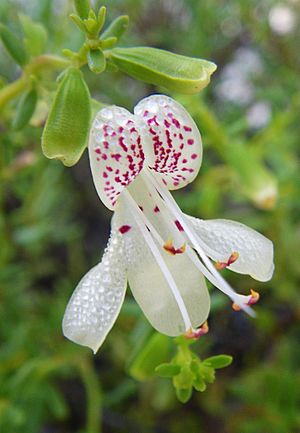Dicerandra facts for kids
Quick facts for kids Dicerandra |
|
|---|---|
 |
|
| Dicerandra christmanii | |
| Scientific classification |
|
| Kingdom: | Plantae |
| Clade: | Tracheophytes |
| Clade: | Angiosperms |
| Clade: | Eudicots |
| Clade: | Asterids |
| Order: | Lamiales |
| Family: | Lamiaceae |
| Subfamily: | Nepetoideae |
| Tribe: | Mentheae |
| Genus: | Dicerandra Benth |
| Synonyms | |
|
Ceranthera Elliott 1821 not P. Beauv. 1808 nor Raf. 1819 |
|
Dicerandra is a group of flowering plants. They are part of the mint family. There are 11 different kinds, or species, of Dicerandra. Six of these species live for many years (perennials). Five species live for only one year (annuals).
The perennial Dicerandra plants grow in small areas in Central Florida. They are found on old sand dunes along the Lake Wales Ridge or near the Atlantic Ocean coast. Over the last 100 years, human buildings have taken over much of their natural home. Because of this, almost all perennial species are now listed as federally endangered. This means they are at risk of disappearing forever.
The annual Dicerandra species grow in larger areas. They can be found across hundreds of miles. Their range goes from the Florida Panhandle to southeastern Georgia. One exception is Dicerandra radfordiana. This plant only grows in two places near the Altamaha river. All Dicerandra plants have special horn-like parts on their anthers. Anthers are the parts of a flower that hold pollen.
Scientists have studied how these plants are related to each other. One scientist, Robin Huck, looked at them in 1987. Later, plant experts at the University of Florida confirmed these studies. They continue to learn more about how these plants evolved.
Where Dicerandra Plants Live
Dicerandra species grow in old sandy areas in the southeastern United States. The annual plants in the north often grow in white, acidic sand. This sand is left over from ancient shorelines from the Pleistocene Ice Age. The perennial plants in the south grow in red sands along the Lake Wales Ridge. They also grow in white sands along the Atlantic coast.
These plants like open spaces. They need areas without many trees. They also prefer soil that drains water quickly. Some Dicerandra plants, like Dicerandra cornutissima, have been seen growing along Interstate 75. This is because machines often clear the land there. This clearing helps create the open habitat these plants need.
Types of Dicerandra Species
Here are the 11 different species of Dicerandra:
- Dicerandra christmanii Huck & Judd
- Dicerandra cornutissima Huck
- Dicerandra densiflora Benth. - found in northern Florida
- Dicerandra frutescens Shinners - also called scrub mint, found in central Florida
- Dicerandra fumella Huck - found in the Florida panhandle and southern Alabama
- Dicerandra immaculata Lakela - also called Lakela's mint
- Dicerandra linearifolia (Elliott) Benth. - also called coastal plain mint, found in southern Georgia, southern Alabama, and northern Florida
- Dicerandra modesta (Huck) Huck
- Dicerandra odoratissima R.M.Harper - also called rose balm, found in southern South Carolina and southeastern Georgia
- Dicerandra radfordiana Huck - also called Radford's balm, found in McIntosh County in Georgia
- Dicerandra thinicola H.A.Mill - also called Titusville mint
See also
 In Spanish: Dicerandra para niños
In Spanish: Dicerandra para niños

